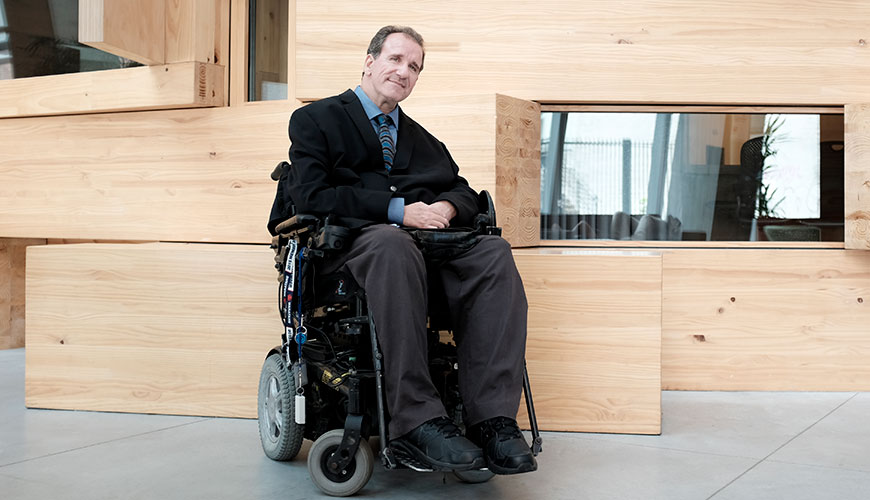Hosting accessible and inclusive in-person meetings and events

Download the 'Hosting Accessible and Inclusive In-person Meetings and Events' PDF guide
Download the 'Hosting Accessible and Inclusive In-person Meetings and Events' DOC guide
1. Overview
This guide provides information on:
- ensuring that the venue for a meeting or event is accessible
- ensuring that participants can access appropriate transport to attend the meeting or event
- ensuring that the invitation to an event is accessible, inclusive and supports requests for reasonable adjustments
- arranging an Auslan interpreter and live captioning
- accessible and inclusive media, presentations and technology
- accessible and inclusive meeting and event materials
- arranging the venue layout so that it is accessible and inclusive
- ensuring activities and games are accessible and inclusive
- arranging catering that is accessible and inclusive.
If you are hosting an online meeting or event, please see the IncludeAbility companion guide to Hosting accessible and inclusive online meetings and events.
The recent COVID-19 pandemic has demonstrated that it can be helpful to have an online meeting facility available if an in-person event has to be moved online at short notice.
2. Introduction
People with disability should be able to access and participate in meetings and events on an equal basis. Ensuring accessibility and inclusivity when people meet together in a work context is not only relevant if you have employees with disability, but also when you coordinate external meetings or events with people whose particular needs you may not be aware of.
You should specifically consider the guidance on hosting an accessible and inclusive in-person meeting or event outlined in this guide in relation to:
- staff induction and training sessions
- regular team meetings
- meetings with external stakeholders, including members of the public
- large events hosted by your organisation
- recruitment processes, such as interviews.
3. Venue
If you are hosting an in-person meeting or event, make sure the venue you intend to use:
- is accessible to wheelchair and mobility aid users, both in relation to entering the venue as well as moving around inside the venue (see section 10 below for further information on venue layout)
- has accessible toilets
- has functioning hearing loops available
- has a public address (or PA) system (microphone and speakers) for meetings or events in a space with poor acoustics or when hosting 16 or more people
- is close to accessible public transport and accessible parking (see section 4 below for further information on transport)
- has an accessible stage or speaker platform (generally with ramps) for people who use wheelchairs or other mobility aids
- has an accessible reception desk or registration area (for example, consider the height of desks, presence of stairs and placement of signage)
- has nearby access to a park or greenery where assistance animals can take breaks.
Ambassador reflection
“There was a lot of inaccessible places and spaces when I first started work and study, and I’ll never forget graduating university and having to do so from the floor of the auditorium while everybody else went up on stage. I gave an address that day from the floor [of the] auditorium and felt cheated.”
Prof Simon Darcy
UTS Business School, University of Technology Sydney
IncludeAbility Ambassador
4. Transport
Once you have confirmed that the venue is accessible, it is helpful to also confirm that the nearby transport options are also accessible. To do this, consider:
- how close the venue is to public transport (for example, buses, trains and ferries)
- whether the available public transport is accessible, or offers regular accessible services
- whether venue drop-off points for taxis and other vehicles are as close to the entrance of the venue as possible
- whether there is a kerb ramp at the drop-off point to allow a person using a wheelchair or other mobility aid to easily and independently move from the road to the entrance
- whether the venue car park includes designated accessible parking spaces and whether you can reserve them.
5. Invitations
Once you have confirmed that the venue is accessible, and that it is supported by accessible public transport, consider the following four key points when creating your meeting or event invitations:
Wording
All meeting or event invitations should include an opportunity for participants to inform event organisers of any accessibility requirements. For example:
If you have any dietary, access, or support requirements in order to participate fully, please let us know when you RSVP to ensure that we can arrange any reasonable adjustments. Please note: the venue is accessible for people using wheelchairs and other mobility aids.
Invitations should use inclusive language and make all invitees feel welcome and supported to participate fully. You may even wish to include examples of common adjustments (for example, Auslan interpreter) to reinforce that you would welcome any requests.
Format and design
Make sure the invitation conforms to readable text guidelines, especially in relation to minimum font size, font type, layout, and colour contrast. Ensure that any digital invitations can be read by screen readers. This includes alternative text (also referred to as ‘alt-text’) for images. This is especially important if the invitation has been graphically designed. Screen readers cannot read text saved into an image file.
Registration
Any ticket booking or registration systems that are used should comply with web accessibility standards.
Transport
Include information about accessible transport options in the invitation. Ensure that the information (including any information provided through external links) is in an accessible format.
Contact person
Clearly include the name of a contact person and their phone and email details so that invitees can get in touch directly with any queries or requests prior to and on the day of the event.
6. Auslan interpreters and live captioning
To support the participation of people who are Deaf or hard of hearing, the following points should be considered to ensure accessibility and inclusion:
Auslan interpreters
Where a participant specifically requests an Auslan interpreter, the event or meeting host should ensure that one is booked. The interpreter should be booked at least three weeks in advance due to high demand. Where the event or meeting will go for more than an hour, it is common practice to book two interpreters to allow for breaks.
If the event is a large public meeting or event where members of the public do not need to RSVP, or it is highly likely that people will turn up without an RSVP, it is best practice to book an Auslan interpreter even if you are unaware of specific participants who require an interpreter.
Live captioning
Participants may also request live captioning for a meeting or event. For large events, such as conferences, it can also be beneficial to have the sessions live captioned on screen.
Live captioning not only benefits people who are Deaf or hard of hearing, but can help all attendees to focus on and follow the presentation. Additionally, captioners will generally provide you with a full transcript of event proceedings afterwards. This may be of particular benefit to participants who are Blind or who have low vision.
7. Media, visual presentations and technology
To support the participation of all people, the following points should be considered in relation to the use of media or interactive technology at events or meetings to ensure accessibility and inclusion:
Videos
Any videos included in a presentation, developed in the lead up to or following an event, should include captions and be audio described.
If a video is not going to be audio described, presenters should be reminded to verbalise any important visual elements such as on-screen text.
Images, photos and diagrams
Any images, photos or diagrams included in a presentation (for example, displayed on a PowerPoint slide) should be described by the presenter so that people who are Blind or low vision can understand the context of what is being presented.
Text
Any text used in a presentation should be written in plain English and include appropriate colour contrast (for example, white background and black font).
Any text that is specifically referred to on the screen should be read aloud as part of the presentation. That is, presenters should not say “As you can all see or read on this next slide …”. Again, this ensures that anyone who cannot see or read the slides can understand the presentation.
Comment platforms
It is becoming increasingly common for event organisers and presenters to use real-time question, comment, and survey platforms online, such as Sli.do or Mentimeter.
While these are great tools for increasing audience engagement, it is important to ensure they are accessible to all participants. From an accessibility perspective it is also helpful to have a second option for people who wish to ask questions but who cannot engage with this technology, such as allowing time at the end of a presentation for any additional in-person questions.
8. Meeting and event materials
To support the participation of all people, the following points should be considered in relation to event and meeting materials to ensure accessibility and inclusion:
- Where possible, circulate PowerPoint presentations to participants who use screen reading technology, or anyone else who requests this accessibility measure, prior to the event.
- Documents to be discussed or used in a meeting (including the agenda, and any meeting papers) should conform to accessible document guidelines, including the use of clear fonts, reasonable text size, and appropriate colour contrast.
Depending on the accessibility requirements of participants, you may also need to consider developing event and meeting documents in other formats such as:
- Braille
- large print
- Easy Read.
Document Accessibility Toolbar (DAT)
The Document Accessibility Toolbar (DAT) is an innovation that revolutionises the creation of accessible documents in Microsoft Word.
The DAT is a dedicated accessibility ribbon menu for Microsoft Word that makes it quicker and easier to create accessible documents. Pioneered by Vision Australia’s Digital Access consultancy, and supported by the Australian Communications Consumer Action Network (ACCAN), it features a range of hand-picked and custom-built functions.
The DAT puts the power of accessible functionality into the hands of content authors, for the ultimate benefit of consumers with disability.
To find out more or to download the DAT for free, visit Vision Australia.
Tip
The NSW Public Service Commission has developed a number of tips to improve accessibility when creating documents: [1]
- When using images in documents, add alternative text to give screen-reader users context that they would otherwise miss by selecting ‘Edit Alt Text’.
- Ensure that any colour contrast is not too low as this makes documents harder to read for people with low vision.
- Use headings in the ‘styles’ function to logically organise information within documents into sections and sub-sections (for example, Headings 1, 2 and 3). Headings act as signposts for screen-reader users and assist them to navigate the document and skip to relevant sections.
- Do not use blank lines in documents. Instead use line spacing, and page and section breaks to avoid confusing screen-reader users.
- Do not use ‘merged cells’ when presenting data in tables to avoid confusing screen-reader users.
- Do not use images or icons in tables as they will not be accessible to people using a screen-reader.
- If documents or emails include hyperlinks, embed the links in a logical way and into words which describe the context of the link instead of using the words ‘click here’.
- Use endnotes in referenced documents instead of footnotes to ensure references are accessible to screen-reader users.
These tips may also be transferrable to other programs such as Microsoft PowerPoint and when using email programs. Microsoft Outlook also has an Accessibility Check function.[2]
9. Venue layout
To support the participation of all people, the following points should be considered in relation to the layout of the selected venue to optimise accessibility and inclusion:
- ensuring there is sufficient, unobstructed floor space for people who use wheelchairs, have mobility aids, or assistance animals
- reserving seating at the front or middle of the venue for people who use wheelchairs or have an assistance animal
- reserving seating at the front of the venue for people who are Deaf or hard of hearing so that they have a direct line of sight to the Auslan interpreter (if applicable)
- reserving seating close to the podium, exit or other facilities for people who indicate this as a requirement
- designating a person to assist people with their requirements at the entrance, such as:
- guiding people to their appropriate seat
- providing information for people using a hearing loop
- indicating where accessible bathrooms and facilities are located.
When arranging the layout of the venue, it is helpful to create a separate quiet area (for example, a breakout space or separate room) to allow participants to take a break away from the main event if required. This can be particularly helpful for people with certain neurological disabilities.
Ambassador reflection
“My colleagues and the businesses with whom we work get a positive boost from successfully negotiating any challenges my disability may pose. Stage technicians, publicists, film crews often delight in fixing problems – not that there are many repeat problems! Once we have overcome a challenge, it rarely repeats. Another positive aspect is that new colleagues and businesses are always pleasantly surprised that the steps required to address a disability are often simple and surmountable.”
Tim Ferguson
Comedian & Screenwriter, Stella Rose Productions
IncludeAbility Ambassador
10. Activities and games
When developing group activities for a meeting or event, it is important to consider the accessibility requirements of all participants to ensure no one is unintentionally excluded.
Many interactive games require participants to move around the room or respond to visual information on a projector or whiteboard (for example, ice breaker or knowledge testing games).
These activities can still be included in meetings and events with modification to ensure that everyone can participate:
Modifying a physical activity
‘Heads and tails’ is a common activity that is used as an ice breaker. Participants are asked to select either their ‘head’ or their ‘tail’ with both hands to indicate their response to a yes or no question.
If a participant is not able to move in this way you can select a different physical response. For example, closing or opening eyes, or turning left or right.
Modifying a visual activity
Where an activity requires a response to visual information, there are several ways to adapt it so that everyone can participate:
- Circulate the material early – provide the visual information early to all participants in an accessible form so that anyone who is Blind or who has low vision will have an opportunity to pre-read the information.
- Make it physical – change the activity to a physical form. Instead of reading material on a whiteboard, ask participants to move from one end of the room to the other, or put their hands on their heads.
- Make it a discussion activity – change the activity to a discussion activity. Instead of responding to material on a whiteboard, create a question for groups to discuss.
11. Catering
To ensure any catering or meal arrangements are accessible and inclusive:
- Ask participants to note any dietary requirements in their RSVP
Many disabilities and illnesses have implications for food and dietary intake, such as diabetes, coeliac disease and anaphylactic allergies.
- Provide different catering choices where possible
Food which does not require a knife, fork, plate or negotiating serving utensils can be helpful for people who have limited mobility or dexterity. Individual sandwiches, wraps, slices and muffins are helpful options.
- Request that catering staff offer to assist participants with their selection and service
- Ensure that there are sufficient seats and tables of appropriate height available
There should be room for everybody to manoeuvre safely between tables. It is also helpful to ensure a range of cutlery and crockery is available at each table.
Endnotes
[1] New South Wales Government, Public Service Commission, Accessible Documents (Web Page, 2021).
[2] New South Wales Government, Public Service Commission, Accessible Documents (Web Page, 2021).
|
This guide is part of a suite of resources developed by the Australian Human Rights Commission as part of IncludeAbility to assist:
Explore our other Disability Employment resources. |



